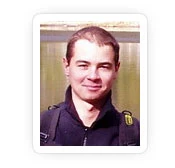Yoga Anatomy: 3 Easy Steps to Hamstring Health

Article At A Glance
Sore Hamstrings are one of the more common problems encountered when teaching and practicing yoga. This article from Dr. Ray Long illustrates a simple three-step process that can effectively break the cycle of sore hamstrings by balancing and distributing the stretch during forward bends.
Hamstring soreness is one of the more common problems encountered when teaching and practicing yoga.
Typically, the pain is present during forward bends such as Uttanasana (Standing Forward Bend Pose) or Paschimottanasana (Seated Forward Bend Pose) and is located in the region of the sitting bones (ischial tuberosities) where the hamstrings originate.
This soreness can become chronic because continuing to stretch the hamstrings in the same manner aggravates the problem. It’s a bit like a bald spot on a tire that gets worse with time unless we balance our wheels.
This article illustrates a simple three-step process that can be effective in breaking the cycle of sore hamstrings by balancing and distributing the stretch during forward bends.
The Basic Science: 
The hamstrings are located on the backs of the thighs. They are composed of three muscles. On the inside of the thighs are the semimembranosus and semitendinosus. On the outside are the biceps femoris.
The hamstrings originate from the ischial tuberosities (except the short heads of the biceps femoris, which originate from the femur). They insert on the lower leg. Contracting the hamstrings bends the knee.
1) Biceps femoris (long head)
2) Semitendinosus
3) Semimembranosus
4) Biceps femoris (short head)
Sore Hamstrings: Overstretching
Typically, when practicing forward bends such as Uttanasana, we straighten the knees and then bend forward. This focuses much of the stretch on the region of the proximal hamstrings at their origin from the ischial tuberosity.
If overstretching occurs and we continue to bend forward in this way, the result can be sore hamstrings that do not get better on their own. This is especially true if we practice repetitive forward bends, as with the Vinyasa Flow series. This soreness is usually located in the region of the sitting bones.
Breaking the Cycle: Try These 3 Steps
Overstretching muscles can create microtears in the substance of the muscle, resulting in an area of weakness. Things in nature tend to follow the path of least resistance. This means that when we stretch a muscle in which a region has been injured, the stretch tends to focus in that region and aggravate the injury—a bit like a bald spot on a tire.
In order to heal the sore area of the muscle, it is necessary to temporarily alter the method of stretching in order to distribute the stretch to a healthy region of the muscle and give the injured part an opportunity to heal.
The following movements aid to distribute the stretch along the length of the hamstrings:
- Bending the knees releases the hamstrings at their insertions on the lower legs.
- Activating the psoas muscles tilts the pelvis forward and stabilizes the origin of the hamstrings. This action draws the torso towards the thighs.
- Maintaining the pelvis by tilting forward and gently contracting the quadriceps to gradually straighten the knees focuses the stretch on the distal regions of the hamstrings and away from the overstretched area at the origin. Contracting the quadriceps also results in reciprocal inhibition of the hamstrings and causes them to relax into the stretch.


© 2007 Raymond A. Long MD. 3 Steps Illustrated above
It is best to build this new method of stretching over time. If pain occurs in the hamstrings, one should back off on the stretch by slightly bending the knees.
If you are new to integrating anatomy into your practice, remember that it is not necessary to memorize this technique on your first pass. Begin by enjoying the beautiful images of the body in yoga. This alone will awaken your brain’s awareness of the anatomy during your practice.
Return later for a closer look, and then gently go through the motions illustrated above as you practice. Then leave it. Your unconscious mind will create new circuitry while you rest. Enjoy this process, and when you return to the mat, you will be surprised at how easily you access this technique
Note:
Always practice under the guidance of an experienced instructor.
Always, in your particular case, consult your healthcare provider before practicing yoga or any other exercise program.
Here’s More Information on Hamstrings and Your Lumbar Spine in Yoga Practice: Ray Long MD and YogaUOnline – How Tight Hamstrings Can Affect Your Lumbar Spine in Yoga.
Reprinted with permission from the dailybanda.com
 Author Ray Long MD, FRCSC, is a board-certified orthopedic surgeon and the founder of Bandha Yoga. Ray graduated from The University of Michigan Medical School with post-graduate training at Cornell University, McGill University, The University of Montreal, and Florida Orthopedic Institute. He has studied hatha yoga for over twenty years, training extensively with B.K.S. Iyengar and other leading yoga masters.
Author Ray Long MD, FRCSC, is a board-certified orthopedic surgeon and the founder of Bandha Yoga. Ray graduated from The University of Michigan Medical School with post-graduate training at Cornell University, McGill University, The University of Montreal, and Florida Orthopedic Institute. He has studied hatha yoga for over twenty years, training extensively with B.K.S. Iyengar and other leading yoga masters.

3D Graphic Designer / Illustrator Chris Macivor has been involved in the field of digital content creation for well over ten years. He is a graduate of Etobicoke School of the Arts, Sheridan College, and Seneca College. Chris considers himself to be equally artistic and technical in nature. As such, his work has spanned many genres, from film and television to video games and underwater imagery.




